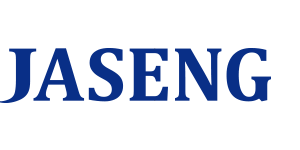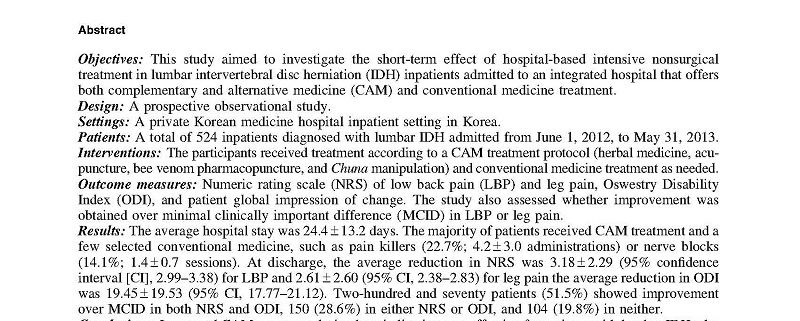The short term effect of integrated complementary and alternative medicine treatment in inpatients diagnosed with lumbar intervertebral disc herniation: a prospective observational study

OBJECTIVES:
This study aimed to investigate the short-term effect of hospital-based intensive nonsurgical treatment in lumbarintervertebral disc herniation (IDH) inpatients admitted to an integrated hospital that offers both complementary and alternative medicine (CAM) and conventional medicine treatment.
DESIGN:
A prospective observational study.
SETTINGS:
A private Korean medicine hospital inpatient setting in Korea.
PATIENTS:
A total of 524 inpatients diagnosed with lumbar IDH admitted from June 1, 2012, to May 31, 2013.
INTERVENTIONS:
The participants received treatment according to a CAM treatment protocol (herbal medicine, acupuncture, bee venom pharmacopuncture, and Chuna manipulation) and conventional medicine treatment as needed.
OUTCOME MEASURES:
Numeric rating scale (NRS) of low back pain (LBP) and leg pain, Oswestry Disability Index (ODI), and patient global impression of change. The study also assessed whether improvement was obtained over minimal clinically important difference (MCID) in LBP or leg pain.
RESULTS:
The average hospital stay was 24.4 ± 13.2 days. The majority of patients received CAM treatment and a few selected conventional medicine, such as pain killers (22.7%; 4.2 ± 3.0 administrations) or nerve blocks (14.1%; 1.4 ± 0.7 sessions). At discharge, the average reduction in NRS was 3.18 ± 2.29 (95% confidence interval [CI], 2.99-3.38) for LBP and 2.61 ± 2.60 (95% CI, 2.38-2.83) for leg pain the average reduction in ODI was 19.45 ± 19.53 (95% CI, 17.77-21.12). Two-hundred and seventy patients (51.5%) showed improvement over MCID in both NRS and ODI, 150 (28.6%) in either NRS or ODI, and 104 (19.8%) in neither.
CONCLUSIONS:
Integrated CAM treatment during hospitalization was effective for patients with lumbar IDH who had severe LBP and disability. However, these results must be investigated further to assess whether the effects surpass those seen with placebo and are cost-effective.




